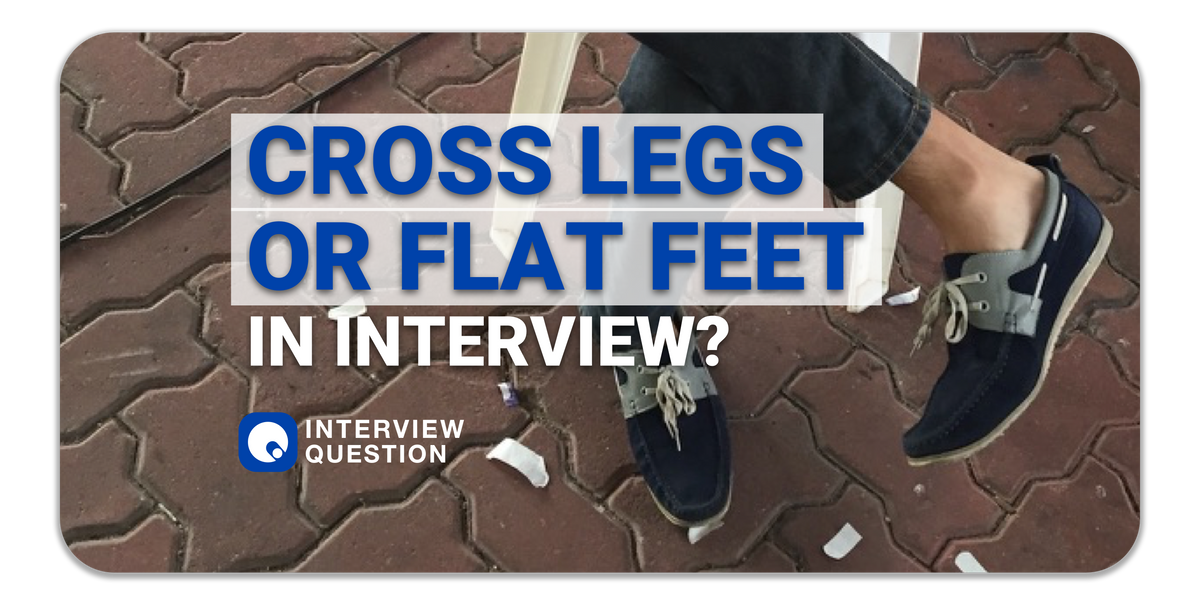Cross legs or feet flat on the floor in an interview waiting room?
Why cross legs is okay | Which foot to cross | When to put feet on flat ground | Comparing cross legs with feet flat | Gender | Attire | Physical interview room restriction | Social standard

Staying composed in a job interview is stressful and nerve-wracking. You may change postures to make yourself a little more comfortable. Your seating position and whether you are physically relaxed can affect your performance. To appear as confident as possible while still appearing natural, there are 2 most used seating styles.
This article will help you understand why crossed legs is a popular technique. The content below also gives you tips on when it’s okay for you to cross your legs during an interview.
Why Crossed Legs During An Interview Is Okay
Crossing your legs during an interview can help you feel more relaxed and confident.
Putting a leg over the other keeps your body language natural and moderately tense. The tightness in your thighs and lower body helps avoiding fidgeting with your clothes or accessories.
You can counteract the tenseness by leaning slightly towards the interviewer. Then, rest your hands in your lap palms up for a few seconds, opening your palm, to help make you appear more comfortable and relaxed.
However, it’s important to know when and how to use these techniques so that the impression you give off don’t come across as artificial instead of genuine. When you cross your legs too high or too close together, it can indicate insecurity rather than relaxation. The key here is knowing when you’re crossing your legs too high or too close together. Keep things loose.
So Which Foot Should You Cross?
It is easier to cross your right foot over the left if you are a right-hander. Your main and dominant leg has prowess. Thus, the stronger leg usually is on top of the weaker leg.
Also, most people cross their legs at the ankle (near the foot) instead of at the knee area. This classic way of crossing feet is less distracting and less unnatural. Further, if you are wearing long pants (for men) or a dress / skirt, it is physically less constricting. The tight materials of your clothing will not bunch up as much.
The other option to cross legs is to cross both ankles together above the knee. Typically interviewees only hold this position for a few seconds before uncrossing them again, as it can get uncomfortable due to the weight of the thigh. When crossing, aim for the knee area. To make this look more natural, slouch forward in your seat slightly so that you don't appear stiff or uptight.
When to put feet on flat ground
Interviewees who are nervous should place feet flat on the floor. Flat feet provides the body with stability, and anchors the person to the ground. Placing both feet on the ground also reduces fidgeting movement like drumming or shaking of legs.
Fidgeting movement is deemed unsightly, a disturbance and in some cases, can be an annoyance. Keeping your legs rooted on the floor will help you be less distracted, feel more steady and overall, make you feel less nervous.
Comparing cross of legs and putting feet on flat surface
Both styles of seating are common ways of presenting personal body language. In an interview room where you may be observed, it is common for candidates to take conscious effort to look presentable.
By gender and attire
For females, crossing legs is preferred as it is more lady-like and demure. Crossing legs should be a habit for ladies to prevent accidental reveal of undergarments while wearing skirts. Closing legs by overlapping one over the other reduces chance of inappropriate exposure.
For males, firm feet on the ground is preferred. It introduces stability and strength. Also, crossing legs for a prolong period may be difficult for men as the bottom regions may get warm. Heat build up can affect fertility and introduce discomfort.
By physical restrictions
In an interview waiting room, space may be limited. Crossing legs may not be possible if candidates are seated next to each other. Thus, the conditions may compel the "foot-down" position.
By social standards
While waiting, it is preferred to sit in a way to mimic other candidates. Copying other people shows you are part of the group and not the odd one out. Be a team player. If others are crossing legs, try to cross yours too.
Conclusion
Sitting posture is a matter of personal preference. However, the way you choose to sit is influenced by context - your gender, attire, interview physical restrictions and your compliance to social norms. Crossing legs and putting legs flat on the floor are both okay. Having some degree of self-conscious about your body language is good to have. Knowing your sitting preferences thus help you be fully present during the interview.
